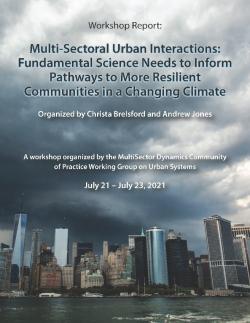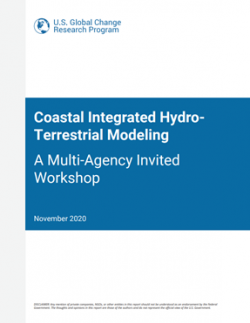About MultiSector Dynamics
MultiSector Dynamics seeks to advance scientific understanding of the complex interactions, interdependencies, and co-evolutionary pathways of human and natural systems, including interdependencies among sectors and infrastructures. This includes advancing relevant socio-economic, risk analysis, and complex decision theory methods to lead insights into earth system science, while emphasizing the development of interoperable data, modeling, and analysis tools for integration within flexible modeling frameworks.

This program area's efforts inform some of the most significant energy, economic, and infrastructure decisions affecting the world today.
Program Area Description
The human-earth system—including settlements, infrastructure, natural resources, socio-economics, and interdependent sectors and natural systems—is highly complex and continuously changing, with stressors, constraints, and other factors that affect change taking many forms and influencing the system at varying spatial and temporal scales, often in unanticipated ways.
Scientific insights and tools emerging from MultiSector Dynamics hold significant potential to inform next-generation U.S. infrastructure and new development pathways for improved energy and economic security, including implications of and for technological and systems innovations.
Topical areas of focus in MultiSector Dynamics include:
- Multi-model, multi-scale frameworks, software couplers, and component emulators
- Interdependencies among energy, water, and land systems and the natural environment
- Infrastructure, sectoral interactions, and resilience under rapid change
- Urban morphologies, population dynamics, and landscape evolution
- Simulation complexity in energy-intensive, multisector regions under stress (e.g., coasts)
- Influences of extreme events and compounding stressors on system shocks and responses
- Scenarios, sensitivity studies, uncertainty characterization, and interpretation of results
- Data science, analytics, fusion methods, and machine learning
Research Emphasis

There is a particular emphasis on understanding the energy-water-land nexus under both realistic and idealized forcing scenarios, including the evaluation of scale-aware processes and probabilistic uncertainties that can lead to instability through thresholds and tipping points.
This major focus area seeks to understand the growing interdependencies and risks at the intersection of the energy, water, and land sectors. The recent disruptive effects and economic losses associated with the growing intensity, frequency, and persistence of droughts, floods, heat waves, and tropical storms in the United States have highlighted the importance of this research and integrated modeling capability. For example, energy is required for water and wastewater treatment, groundwater pumping, and large-scale inter-basin transfers. Needs, risks, and vulnerabilities of the coupled system are large and growing in the face of shifting weather and precipitation patterns, water supplies that depend on increasingly limited groundwater, transitions in regional economic development (including land use), as well as U.S. population shifts. In contrast, approximately 45% of water withdrawals in America’s rivers and streams are for energy applications, ranging from thermo-electric cooling (e.g., fossil and nuclear power plants) to domestic oil and gas recovery. Hydropower is similarly challenged to respond to increasing competition for limited water supply.
Besides the focus to understand the system dynamics governing interdependencies within the natural-human system, this area seeks to advance scientists' understanding of system nonlinearity and instability associated with multiple stressors that can lead to cascading failures in connected sectors and systems. An important characteristic of nonlinearity and system failure is the probabilistic interdependence near thresholds associated with extreme weather, severe drought, and infrastructure vulnerability. Consequently, MultiSector Dynamics supports the development of interoperable tools and methods for integration with agile, flexible earth system modeling frameworks, revealing a basic understanding of different levels of complexity required to analyze interdependency.
Funding Opportunity Announcements

(C-IHTM) Workshop Report (2021) reflects a workshop series focused on the challenges of modeling and evaluating coastal landscapes of co-evolving human and natural systems. Download PDF.
Announcements are posted on the DOE Office of Science Grants and Contracts Website and at grants.gov. Information about preparing and submitting applications, as well as the DOE Office of Science merit review process, is available at the DOE Office of Science Grants and Contracts Website. For current announcements visit BER Funding Opportunities.
Why MultiSector Dynamics' Research is Important
MultiSector Dynamics efforts are necessary to understand the nonlinear science involving natural-human interdependency and feedbacks on the earth system. This program area helps shape fundamental understanding of complex stressors on human systems and infrastructure, vulnerabilities and risks at the energy-water-land nexus, multisector dynamics, and more generally, implications for regional and global economic development in the face of changing weather patterns and extremes, advances in technology, availability of natural resources, and feedbacks to natural systems, including regional and global climates.
Featured Reports
- eBook: Addressing Uncertainty in MultiSector Dynamics Research (July 2023) Read online | Download PDF
- MultiSector Dynamics: Scientific Challenges and a Research Vision for 2030 (January 2022)
- Multi-Sectoral Urban Interactions: Fundamental Science Needs to Inform Pathways to More Resilient Communities in a Changing Climate (October 2021)
- Coastal Integrated Hydro-Terrestrial Modeling: A Multi-Agency Invited Workshop (November 2020)
- Understanding Dynamics and Resilience in Complex Interdependent Systems (December 2016)
- Multi-Scale Economic Methodologies and Scenarios Workshop (August 2016)
- Towards Scenarios of U.S. Demographic Change: Workshop Report (July 2015)
- Need and Options for Subnational Scale Land-Use and Land-Cover Scenarios for the United States (January 2015)
- The Water-Energy Nexus: Challenges and Opportunities (June 2014)
- Climate and Energy-Water-Land System Interactions (March 2012)
- Community Modeling and Long-Term Predictions of the Integrated Water Cycle (September 2012)
